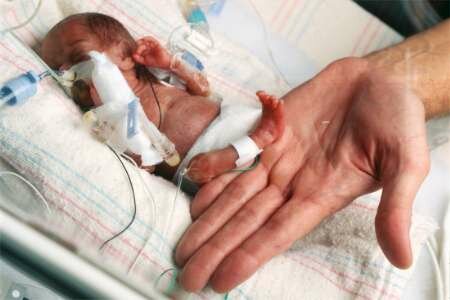Wed 22 Dec 2004

Neonatalogist Dr. Jonathan Muraskas places his hand next to Rumaisa Rahman, known to be the smallest baby in the world to survive birth, in this file photo taken three weeks after birth, at Loyola Medical Center in Maywood, Illinois. Rahman weighed 8.6 ounces at birth, about the size of a cellular phone. Reuters/Handout/Oscar Izquierdo
JIM RITTER, The Chicago Sun-Times reports:
No baby as tiny as 8.6 ounces had ever survived before Rumaisa Rahman was born Sept. 19.
Although no bigger than a cell phone, Rumaisa still had some things in her favor, doctors at Loyola University Medical Center explained Tuesday as they introduced her to the media.
Rumaisa spent nearly 26 weeks in the womb before she was delivered by Caesarean section, along with her twin sister. That’s three weeks longer than the minimum needed to survive.
“It’s how long you’ve been in the oven that’s important, not how small you are,” said neonatologist Dr. Jonathan Muraskas.
Rumaisa was remarkably free of infections, collapsed lungs, pneumonia or other serious complications common in preemies.
And, she was a girl. Of the world’s 20 smallest surviving babies, 18 are female.
“Boys are the weaker sex,” Muraskas said. “Girls do better developmentally.”
Rumaisa is expected to go home to Hanover Park during the first week of January. Her fraternal sister, Hiba, is scheduled to go home next week.
“This is a very proud moment for us,” said the girls’ father, Mohammed Abdul Rahman. “Not only because my daughter broke the record, but because she is doing well.”
While it’s too early to know for sure, Rumaisa and her sister “have a great chance of being normal,” Muraskas said.
Rumaisa broke the record held by another Loyola preemie, Madeline Mann, who weighed 9.9 ounces when she was born in 1989. Madeline now is an honor student at Conant High School in Hoffman Estates.
Costs steep for premature care
But the number of preemies is increasing, and many die or suffer disabilities such as cerebral palsy, mental retardation, chronic lung disease, blindness and hearing loss, said Dr. Siobhan Dolan of the March of Dimes. “More research on the underlying causes of preterm birth is needed to reverse this trend.”
Caring for preemies is extraordinarily expensive. Loyola’s neonatal intensive care unit costs about $5,000 per day. At that rate, the bill for Rumaisa and Hiba would total around $500,000. Medicaid is paying the bill, a hospital spokesman said.
The girls’ 23-year-old mother, Mahajabeen Shaik, was born in India and became a U.S. citizen after moving here in 1996. Her husband is a customer service representative who moved here after they married.
“They’ve been very involved, wonderful parents,” Muraskas said.
Twins run in Mahajabeen’s family, but her first pregnancy proved to be difficult. She grained 45 pounds and developed severe high blood pressure. The condition endangered the babies, so doctors performed a C-section at 25 weeks, six days.
Chances only 50-50
Babies born at that stage normally weigh about 1 pound, 10 ounces. Rumaisa weighed only one-third as much. Doctors gave her a 50-50 chance of surviving. Hiba weighed 1 pound, 4 ounces.
The girls were put on breathing machines, and placed in incubators that kept them at 98.7 degrees.
Rumaisa was fed through an IV line and later a tube in her nose. She underwent laser surgery to fix a vision problem common in preemies. Her head is normal, and there’s been no bleeding in the brain, a common complication that increases the risk of cerebral palsy.
The girls are taking milk with a bottle and steadily gaining weight, and soon will go off supplemental oxygen.
“We want them to get a good education and be good human beings and citizens,” their dad said.
Their mom added that she hopes they grow up to be doctors.
The world’s tiniest surviving babies
# Rumaisa Rahman, born in 2004 at Loyola University Medical Center in Maywood, 8.6 ounces.
# Madeline Mann, born in 1989 at Loyola, 9.9 ounces.
# Girl born in South Shields, Britain, in 1938, 10 ounces.
# Girl born in Florence, Italy, in 2002, 10.1 ounces.
# Girl born in Tokyo in 1999, 10.2 ounces.
SOURCE: Children’s Hospital of Iowa